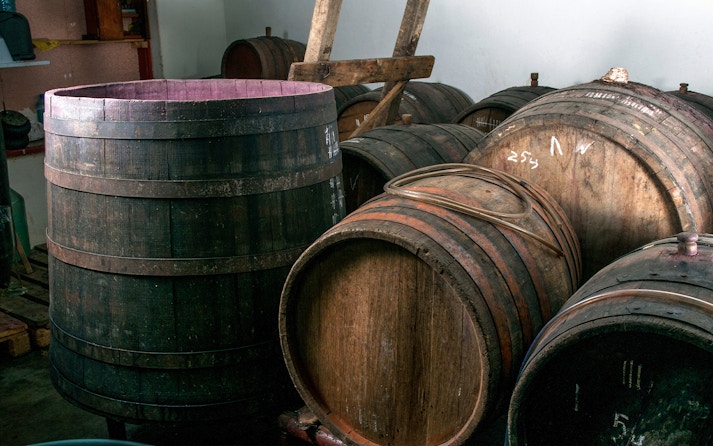- St. Marks Basilica
- St. Mark’s Museum
- St. Mark’s Terraces
- St. Mark’s Campanile
- St. Mark's Square
- History
- Architecture
- Inside
- Highlights
- Pala d'Oro
The Fascinating St. Mark's Basilica History - From 9th Century Church to Venetian Seat of Power
A favorite among the religious and political domains of Venice, St. Mark’s Basilica is a 1000-year-old city legacy. The Basilica di San Marco in Italian or otherwise known as the “church of gold” is today renowned around the globe for its beautiful mosaic work and holds the remains of St. Mark that were transported from Alexandria, Egypt. Read on to uncover the fascinating history of St. Mark’s Basilica and why you must visit this intriguing monument!
History of St. Mark’s Basilica

Origins in the 9th Century
The Basilica di San Marco was originally built to enshrine the relics of a saint, which had been brought to Venice by traders in a barrel filled with pork after being secretly taken from Egypt. During a treacherous storm that threatened to overturn the ship, the saint's ghost appeared to guide the sailors to lower the sails, saving them from impending disaster. As a testament to this miraculous event, a fresco depicting the supernatural intervention was made, and you can see this inside the basilica.

Reconstruction & Rebirth
976 AD - 978 AD
In 976 AD, a populist uprising targeted the Doge, resulting in the furious mob setting fire to the castrum. The flames swiftly engulfed the adjoining church, severely damaging it. Consequently, the assembly relocated the Doge election ceremony to San Pietro di Castello. Despite damage, the basilica's core structure endured. Over time, successive Doges oversaw rebuilds and expansions after fires, shaping its architectural evolution.

Ambitious construction projects
1063 AD - 1094 AD
The 11th century witnessed ambitious construction initiatives that transformed St. Mark's Basilica into its enduring form. Under the patronage of Domenico Contarini, significant construction projects elevated the architectural landscape and grand appeal of basilica. A pivotal moment arrived in 1094 AD when Vitale Falier presided over the basilica's consecration, cementing its spiritual importance as a revered center of faith in Venice.

Relations with the East
800 - 1300 AD
Venice's intensified trade, cultural exchanges, and maritime dominance catalyzed its influence in the Eastern Mediterranean. The city-state emerged as a vital hub for commerce and cultural interaction with Byzantium. In the 12th century, Venice's pivotal involvement in the Fourth Crusade significantly altered its destiny. The campaign secured vast riches and art treasures from Byzantium, strengthening Venice's regional dominance and cultural prosperity.
Influence of the Fourth Crusade
12th - 15th Century
In 1204, the Fourth Crusade brought plundered treasures from Constantinople to St. Mark's, enhancing its artistic wealth and stature. Throughout the 13th to 15th centuries, St. Mark's Basilica prominently showcased Byzantine and Eastern artistic styles, influencing its architecture, art, and cultural essence. It also shaped the basilica's unique appearance and cultural position, symbolizing Venice's enduring ties to the East.

Transformation in the 19th Century
1807 AD
During the 19th century, marked political changes redefined St. Mark's Basilica's role. In 1807, under Napoleon's orders, the basilica underwent a significant transformation. It ceased to serve solely as a symbol of the city's historical and religious significance and was repurposed as the seat of the Patriarch of Venice. The basilica shifted its role to become more ecclesiastical, concluding a thousand-year association with the Venetian Doges.
About St. Mark's Basilica today
Book your St. Mark's Basilica Tickets
Frequently asked questions about St. Mark’s Basilica history
St. Mark’s Basilica is roughly 1100 years old. The foundation of the basilica dates back to the 9th century when it was established to house the relics of Saint Mark. However, its present structure largely emerged around the 11th century.
St. Mark's Basilica holds immense historical value as a symbol of Venetian power, spirituality, and artistic brilliance. It not only shelters the relics of Saint Mark but also symbolizes Venice's connection to the Byzantine world and its rise as a major maritime republic.
The construction of the basilica was not a singular endeavor but rather evolved over centuries. The initial structure was built in the 9th century, and subsequent renovations and enhancements spanned several decades.
St. Mark’s Basilica is called the “church of gold” making it extremely famous among travelers to enjoy the mosaic art and other elements from the ancient era to the 19th century.
Domenico Contarini, the 30th Doge of Venice was involved in building St. Mark’s Basilica. Notable patrons such as Giustiniano Particiaco also played crucial roles in its development and expansion.
St. Mark's Basilica architecture exhibits a unique fusion of Byzantine and Gothic styles. Primarily Byzantine in design, it features domes, intricate mosaics, and luxurious decoration. The exterior displays Byzantine features, while the interior reveals a fusion of styles, incorporating mosaic designs, marble columns, and detailed ornamentation that evolved through various periods of construction and renovation. This diverse blend of architectural influences contributes to the basilica's distinct and striking appearance.
The basilica's creation was deeply rooted in Venice's historical and cultural ties with Byzantium. It served as a testament to Venice's rising power and its establishment as a significant maritime republic.
The basilica faced several fires and reconstructions, notably the fire of 976 AD, which led to its rebuilding and expansion. Additionally, it played a vital role in Venetian ceremonies and state affairs.
The basilica's iconic horses, originally from Constantinople, were looted during the Fourth Crusade and later placed atop the facade. Additionally, its precious mosaics and treasures hold stories of trade, conquests, and the city's reverence for Saint Mark.
Absolutely! Visiting St. Mark's Basilica offers a profound experience of Venice's cultural and historical heritage, showcasing remarkable architectural beauty, artistic treasures, and centuries-old tales of spiritual significance.
Yes, St. Mark's Basilica guided tours are available that provide in-depth explanations of it's history, architecture, and significance. These tours, led by knowledgeable guides, offer insights into the basilica's construction, its mosaics, artworks, and the historical context behind its creation.



